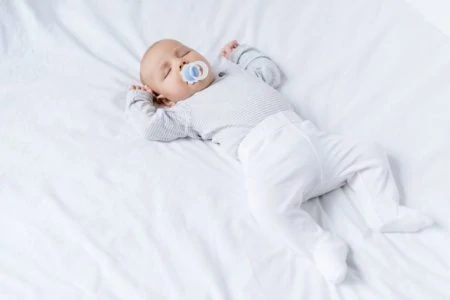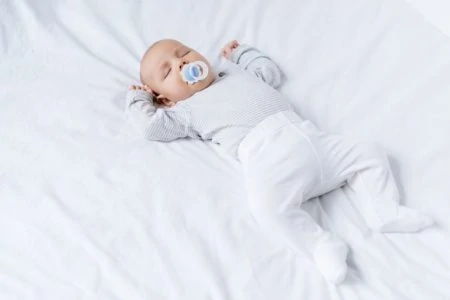Believe it or not, there will come a day when you get some sleep again, and it might be here sooner than you think. Sleep training can be a great way to help your children not only fall asleep faster but even sleep through the night.
In this article, we’ll talk about the magic of sleep training your twins. We’ll talk about when to start, the different ways you can do it, and some of the unique sleep training challenges that come with multiples.
Key Takeaways
- Twins can be sleep trained, but it may take more time and patience than with single babies.
- Recommended age to start sleep training is 4 to 6 months, but it’s not too late for older babies.
- Several sleep training methods are available, such as No Tears, Fading, Pick Up Put Down, and Ferber.
- Establishing routines, using white noise, and separating feedings can aid in sleep training twins.
Identical, But Individuals
Before we start, there is one big thing I need to say. This is not going to be the first time you hear this tidbit, and it surely won’t be the last, but it is important. Even as infants, your twins are two completely different people.
Just as they will probably take different career paths when they get older, their paths to sleep training might be different too.
That doesn’t mean it’s impossible to sleep train twins — it just means you cannot expect it to happen as fast as it would for a single baby. Also, if your twins were born prematurely, their developmental timetable is different. Babies born early will likely reach their milestones at different ages than full-term babies.
You can get your twins on the same sleep schedule, but it will take time and patience on your part. One twin might catch on before their sibling does, but that’s OK. They will both get there eventually.
The Time Has Come
It’s hard to decide when to sleep train one child, and two children at once is a whole other ballgame. But double the crying and double the sleep deprivation can take its toll on parents. Sleep training can help your babies sleep through the night, enabling you to function like a normal human being again.
But at what age are your twins ready to sleep train? How soon is too soon? And is there a time when it’s too late?
Here are some guidelines to help you decide when to sleep train your twins. While these are general age categories, if your babies were born prematurely, you may want to use their adjusted age as a guideline for these developmental milestones.
Newborns
The main thing your newborns need to do for the first two months of their lives is bond with their parents. During this time, it’s best to hold off on sleep training. Instead, focus on getting to know your babies and their individual personalities.
At 2 to 4 Months
It is possible to sleep train your twins during this period, but it will probably be difficult. At this age, many children are still waking up often to eat, so the chances are high they won’t be able to sleep through the night.
At this age, your babies’ circadian rhythms are still developing, so it’s not unusual for them to wake often day and night.
Editor's Note:
Michelle Roth, BA, IBCLCAt 4 to 6 Months
This age range is when most experts recommend starting to sleep train (1). While the 4-month sleep regression can set you back a few weeks, most babies start dropping their nighttime feedings around 4 to 6 months and are ready to sleep for longer stretches.
Babies this age are not yet mobile or able to pull themselves up and out of their cribs.
At 7 Months or Older
If you didn’t sleep train at the 4-to-6-month mark, you might be worried you missed your chance. Your babies might be crawling, pulling up, or even ready to climb out of their cribs. They might also be hitting the 8-to-10-month sleep regression, making you even more exhausted.
Don’t worry; it is not too late to sleep train your twins. It just might take a little more effort and a few more trips to put your twins back into the cribs.
Sleep Training Twins and the Cry-It-Out Method
Many people treat sleep training as a four-letter word, something that is dirty and should never be mentioned in the world of good or gentle parenting. When they hear of sleep training, they think of babies lying in their crib crying for hours on end.
I’m going to let you in on a secret — sleep training is not the same as the cry-it-out method.
While cry-it-out is a method for sleep training, it’s only one of many. Most sleep training methods do not entail letting your child cry, and you can choose whatever method feels right for you and your twins.
Here are a few options you can choose from:
1. No Tears
Sleep training does not always mean you have to let your baby cry. There are several tear-free methods available for a gentle approach to sleep training.
You can go at the pace your babies set. You can do things like rocking your baby to sleep, introducing a lovey, or even co-sleeping to bring your baby comfort.
Another method is comforting your baby to the point of drowsiness and then laying them in their bed to fall asleep independently. If your babies start to cry, go in and comfort them immediately, then lay them down again once they are soothed.
2. Fading
This method is all about a gradual fading out of comfort and support for your twins at bedtime. Think of it kind of like a slow wean.
Start with the same amount of support you always give, whether patting, rocking, or feeding. Then you slowly decrease the amount of time you do it over several days or weeks (2).
This method can take a while, but eventually, you will get to a point where you no longer need to soothe your twins to sleep, and they can do it all on their own.
3. Pick Up, Put Down
Also sometimes shortened to simply PUPD, this method allows your baby to cry a bit but also relies on your comforting them to help them get used to sleeping on their own (3).
Lay your baby down to sleep, then leave the room. But don’t just head into the kitchen and start on that glass of wine you’ve been thinking about all day. Wait outside the bedroom door or take a baby monitor with you, and listen to what your twins do next.
If you hear them fussing or crying, do not run in right away — take a moment to listen. Are they calming themselves down? Great, let them self-soothe!
If they do not begin to calm themselves within a few moments or they start to get fussier, feel free to go in and pick up your babies. The key is to hold them only as long as it takes for them to calm down, then put them back into the crib and start the process again.
Be Prepared
4. Ferber
The Ferber Method was created by Richard Ferber, who founded the Center of Pediatric Sleep Disorders in Boston (4). While his method does not fully call for crying it out, it does allow your child to cry a bit more than the previous methods.
With this method, you make sure to put your babies down in their cribs while they are awake. Then you will gradually leave them alone for more extended periods, even if they are crying. When you go in to comfort your babies, you should pat their back or cuddle them for comfort but not pick them up or feed them.
This progressive waiting, or controlled crying, as Ferber termed it, teaches children to soothe themselves and eventually fall asleep on their own.
Things To Consider When Sleep Training Twins
Can They Share a Crib?
Many parents choose to have their twins share a crib, both for the babies’ comfort as well as for practical purposes. But does this work while sleep training? The short answer is yes — at least, part of the time.
It is perfectly OK for your twins to continue sharing a crib at bedtime (5). That’s because nighttime sleep training usually progresses faster than naptime sleep training. Your babies have enough melatonin built up in their systems overnight that it is easier for them to sleep through their sibling’s cries.
White Noise
White noise is a great help — no matter how many babies you are trying to sleep train. You can use it next to your babies if they share a crib, and some parents double and even triple the power by putting babies into separate cribs.
Putting one machine next to each crib and a fan between the two to help block out one baby’s cries from waking the other.
White noise can also:
- Reduce stress: The world, even outside their bedroom door, can be very stimulating for babies. And stimulation causes stress (6). White noise blocks out the noises and actions around your baby to help them relax and get a good night’s sleep.
- Help babies sleep longer: Blocking out the stimulants outside of your babies’ door will not only help them to stress less, but it can also help them to sleep longer. You see, your babies have internal alarm clocks that take them in and out of a deep sleep cycle (7). When your babies are in a lighter part of their sleep cycle, it is easier for them to be startled and woken up, but white noise works by not only softening this internal alarm clock but also by blocking out the noise.
Routines Are Vital
Routines are vital throughout the day to help your babies feel comfortable and stress-free. But believe it or not, they are even more important during bedtime. Studies show children who have a predictable bedtime routine go to sleep faster and sleep better than those who don’t (8).
It doesn’t have to be a long and drawn-out process. A few short steps such as a bath, story, and singing your babies’ favorite song can help. It can even include drawing down the shades and giving your child their favorite lovey.
The important part is that it is consistent — the same order every night — so your babies know that bedtime is on the way and it’s time to start winding down.
Separate Feedings
When your babies are little, it makes more sense to wake one baby up to feed if their sibling is up and crying anyway. By feeding them both at the same time, you allow yourself to get more sleep in between.
When it’s time to start sleep training, though, you want to let your children sleep as long as they can, and this means only feeding the one who originally wakes up. This might mean you are up more at night in the beginning. But it will also allow your babies to naturally sleep longer stretches, and eventually through the night, as you let them wake up only when they are hungry.













